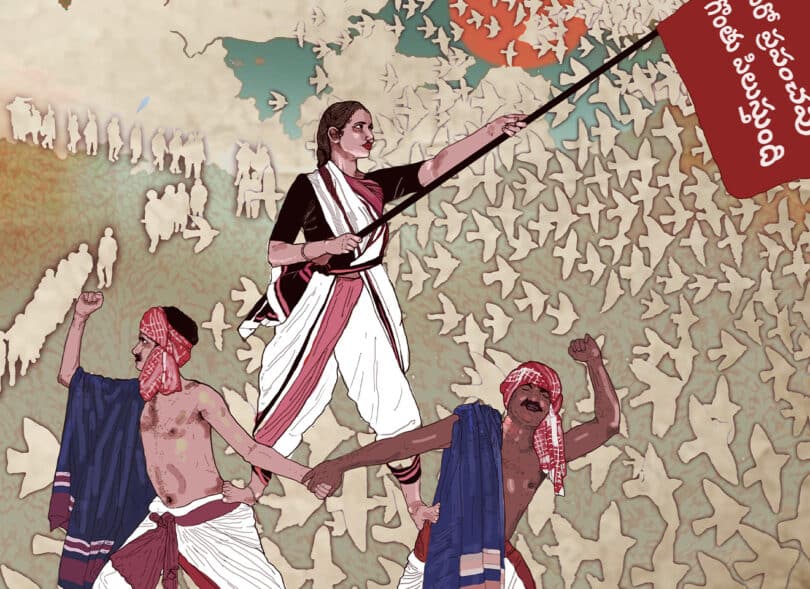In 1934, the Telugu poet Srirangam Srinivas Rao (1910–1983), popularly known as Sri Sri, wrote a poem called Maha Prasthanam (Forward March). The poem was unlike anything previously heard in the Telugu language, which is now spoken by almost 100 million people in south-central India and its diaspora. Sri Sri’s poem would be sung like a military march, except that the words were not for the military but for revolutionaries who wanted to overthrow the British colonial state and establish a socialist India. The words are simple, almost clichéd in their simplicity, but they are authentic:
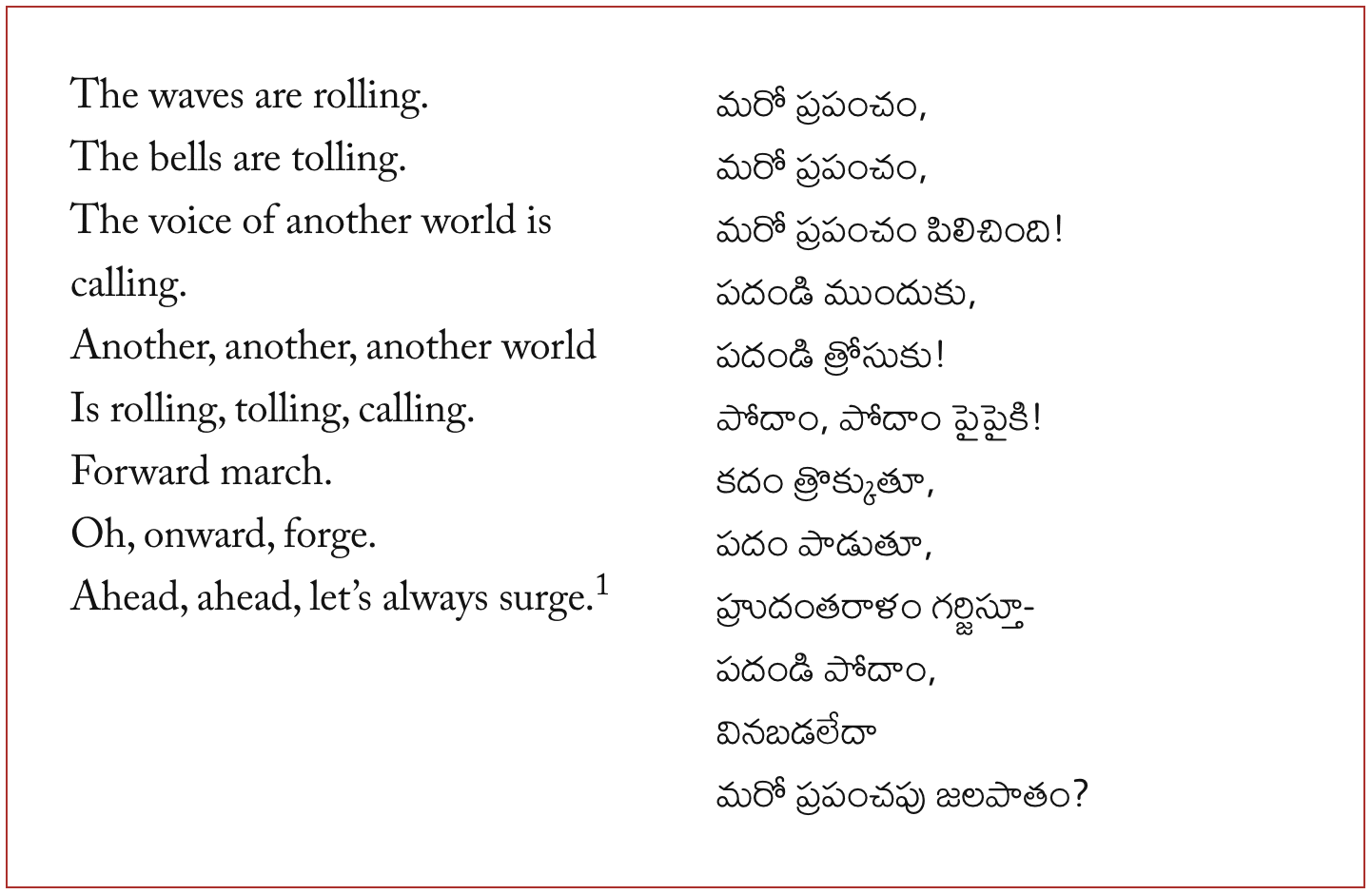
The song was intended to give the people confidence in their abilities as well as the necessary inspiration to take on a seemingly intractable enemy. Anything is possible if you believe in yourself, Sri Sri seemed to be saying. But what would be the point of sacrifices if the end result was failure? The future called out to the people to tell them that their struggles would not be in vain. That certainty of eventual success, which required sacrifices and struggle, was inspiration enough. Forward.
1. Vimalakka, a revolutionary artist and singer. Credit: Kurella Srinivas
2. Mahankali Parvati (left), Moturu Udayam (middle), and Chintala Koteshwaramma (right) perform an anti-war song during World War II with the group they led, Burrakatha Squad. Credit: Praja Natya Mandali Photography Archives, photographer unknown
3. Mallu Swarajyam, a communist revolutionary hero (left), with other women fighters of the armed struggle in the late 1940s. Credit: Sunil Janah
The Telugu People’s Struggle for Land and Dreams builds on the idea that art and culture are both produced by the class struggle and, in turn, produce the class struggle. In this dossier, we catalogue the immense cultural production of the great struggles that gripped this part of India and how this cultural production inspired the people to participate in cycles of protest. This is not a comprehensive study of radical Telugu literature, nor is it a full history of the communist movement in the Telugu-speaking region of India. We share this text with you with the hope that it will spur further study about the relationship between art and politics as well as the cultural world of the Telugu people’s class struggle.
We focus on songs because, in a society that was prevented from being fully literate, storytelling and songs were the primary form of democratic culture before the advent of cinema. The communist hero of the Telangana armed struggle Mallu Swarajyam (1931–2022) reflects on how women and oppressed-caste Dalits would fill the village air at night with songs of the oppressed as they worked to de-husk rice. The songs were about their lives and their gods. ‘Under the moonlight’, Swarajyam recalls, the singing was so beautiful that even ‘people who were asleep enjoyed these songs’.2
These songs were derived from folk art traditions prevalent in Telugu society such as various forms of storytelling that use song and theatre to re-enact performances of Harikatha (the Hindu mythology of Lord Vishnu), Pakir patalu (a trove of Sufi songs), Bhagavatam (stories from the Sanskrit epic Mahabharata), and non-religious practices such as Burrakatha and Gollasuddulu, both of which tell stories of workers and peasants with two drums accompanying the singer. It was in these musical forms that the workers and peasants contested the worldview of the dominant castes. And it was in this part of the popular imagination that the Left intervened very early in the struggle for social transformation. When Mallu Swarajyam went to at least thirty villages to start the revolt, she said, ‘I started a revolutionary fire in the people with the song as our vehicle. What more did I need?’.3
4. Gummadi Vithala Rao, popularly known as Gaddar, one of the most influential Telugu-speaking revolutionary songwriters, performs for spectators, first by singing and dancing to a line in one of his songs and then pausing to explain its political and historical significance. Credit: KN Hari
5. Telugu poet Srirangam Srinivas Rao, popularly known as Sri Sri, reads a poem from his anthology Maha Prasthanam (Forward March), yellow cover featured on the bottom right, to marchers joining the struggle to fight for another under the red flag (back right). Credit: Kurella Srinivas, 2009
6. Praja Natya Mandali performs a street play. Credit: Praja Natya Mandali Photography Archives
We Don’t Want this White Lord’s Rule
Colonial rule suppressed the social development of most of the Indian subcontinent. The basic statistics are shocking: the average life expectancy from 1881 to 1921 was around 25 years, and infant mortality rates exceeded 200 per 1,000 births.4 Social reform movements from below did not impact most regions of India, where ancient, caste-ridden restrictions in arenas such as the education of girls and women, child marriage, and the prevention of widow remarriage suppressed the possibilities of social life.
This was not the case in parts of southern India, however, including in the Andhra-Telangana region, where social reform took root in the late nineteenth century.5 Writers such as Kandukuri Veeresalingam (1848–1919), Gurajada Apparao (1862–1915), and Garimella Satyanarayana (1893–1952) campaigned for the education of girls, for widows’ right to remarry, and against the Nauch or Devadasi system, in which young girls from oppressed-caste families were dedicated to gods (meaning that they were sent to live in and become the property of temples) and then sexually exploited by dominant caste men.6 To overcome the low literacy rate, social reformers in the region used songs and plays to take their message to the people.7 Gurajada Apparao, for instance, wrote songs in the janapada folk tradition, which were easy to memorise and sing as they used the language of the people. Garimella Satyanarayana’s Swarajyya Geethalu (Songs of Self-Rule) was so powerful that the British banned it in 1921 and then imprisoned the poet for a total of three and half years under the sedition laws.8 Satyanarayana’s immensely popular song Makoddi Tella Dora Tanamu (We Don’t Want this White Lord’s Rule), which was also banned by the government, opens with the verse:
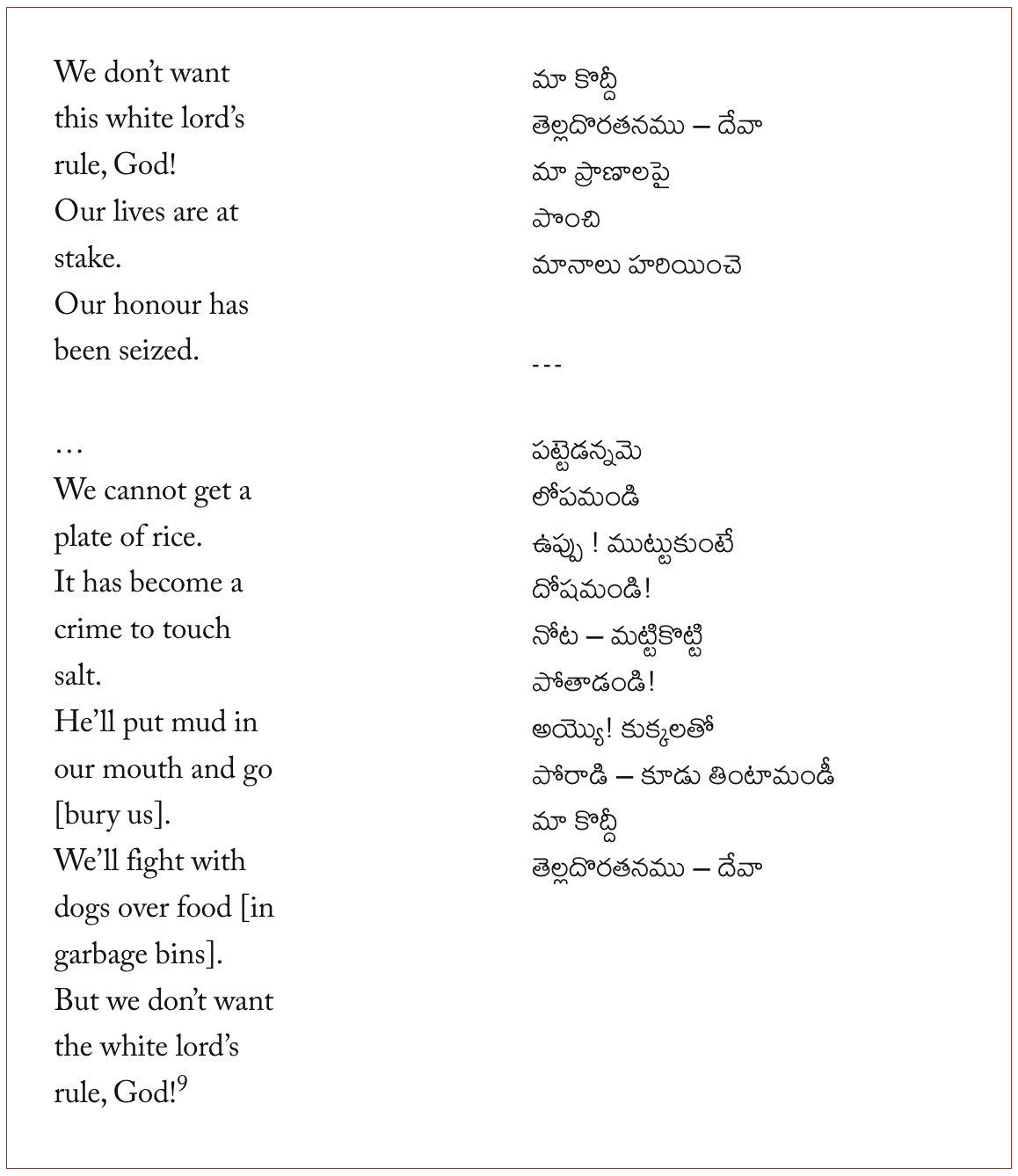
Rather than ruling the subcontinent directly, the British cultivated monarchs and feudal lords to rule on their behalf, provide the colonial state with revenue, and maintain order through the administrative practices of these feudal lords. The Nizam (hereditary ruler) of Hyderabad, who was one of the richest men in the world, dominated three linguistic regions: Telangana (Telugu-speaking), Marathwada (Marathi-speaking), and Hyderabad-Karnataka (Kannada-speaking). The Nizam disregarded the cultures of the people over whom he ruled, forcing them to utilise the Urdu language for official interactions, even though this language was only spoken by 12 percent of the population.10 Language was only one of the many vectors of oppression and exploitation. On behalf of the British Empire, the Nizam ruled over a feudal system rooted in the caste hierarchy peculiar to the region. The landlords, who were solely from dominant castes, extracted wealth and maintained power by exploiting and subjugating various oppressed castes (including by using forced labour).
Every teaspoon of exploitation and oppression is met with a tablespoon of struggle. The people of the region organised themselves through various means, many of which are not recorded in history books. In 1921, people such as Madapati Hanumantha Rao (1885–1970) and Raja Bahadur Venkat Ram Reddy (1869–1953), who were both from middle-class families and were employed by the Nizam’s administration, set up the Andhra Jana Sangham (Andhra People’s Assembly, or AJS). Frustrated by the discrimination against their language, they established libraries, reading rooms, and schools in Telugu (including one of the first girls’ schools in Hyderabad in 1928). Professor Adapa Satyanarayana, who studies the cultural history of Telangana, writes that through the AJS, the library movement ‘emerged as one of the most significant socio-cultural movements and contributed to public awakening’ in the first part of the twentieth century.11
In 1928, the Andhra Jana Sangham was renamed the Andhra Mahasabha (the Grand Andhra Assembly, or AMS) under the leadership of Madapati Hanumantha Rao. Many of the younger leaders of the AMS, such as Baddam Yella Reddy (1906–1979), Ravi Narayan Reddy (1908–1991), and Devulapalli Venkateshwar Rao (1912–1984), joined the communist movement and pushed this ‘liberal cultural organisation’, as historian Sunil Purushotham writes, to become ‘a militant mass organisation’.12 As a mass organisation, the AMS took its message to the people through forms of folk art that were already popular, such as songs and plays that illuminated the structure of British colonialism, the Nizam’s rule, and landlords’ grip on the rural world. The AMS leaders rooted the peasants’ struggles in an understanding of the world at large, galvanised by the threat of Nazism in Europe and its implications for India. In 1933, the great radical poet Sri Sri wrote Jayabheri (Victory’s Drum), which captured the sense of anger that permeated the artists of his day:
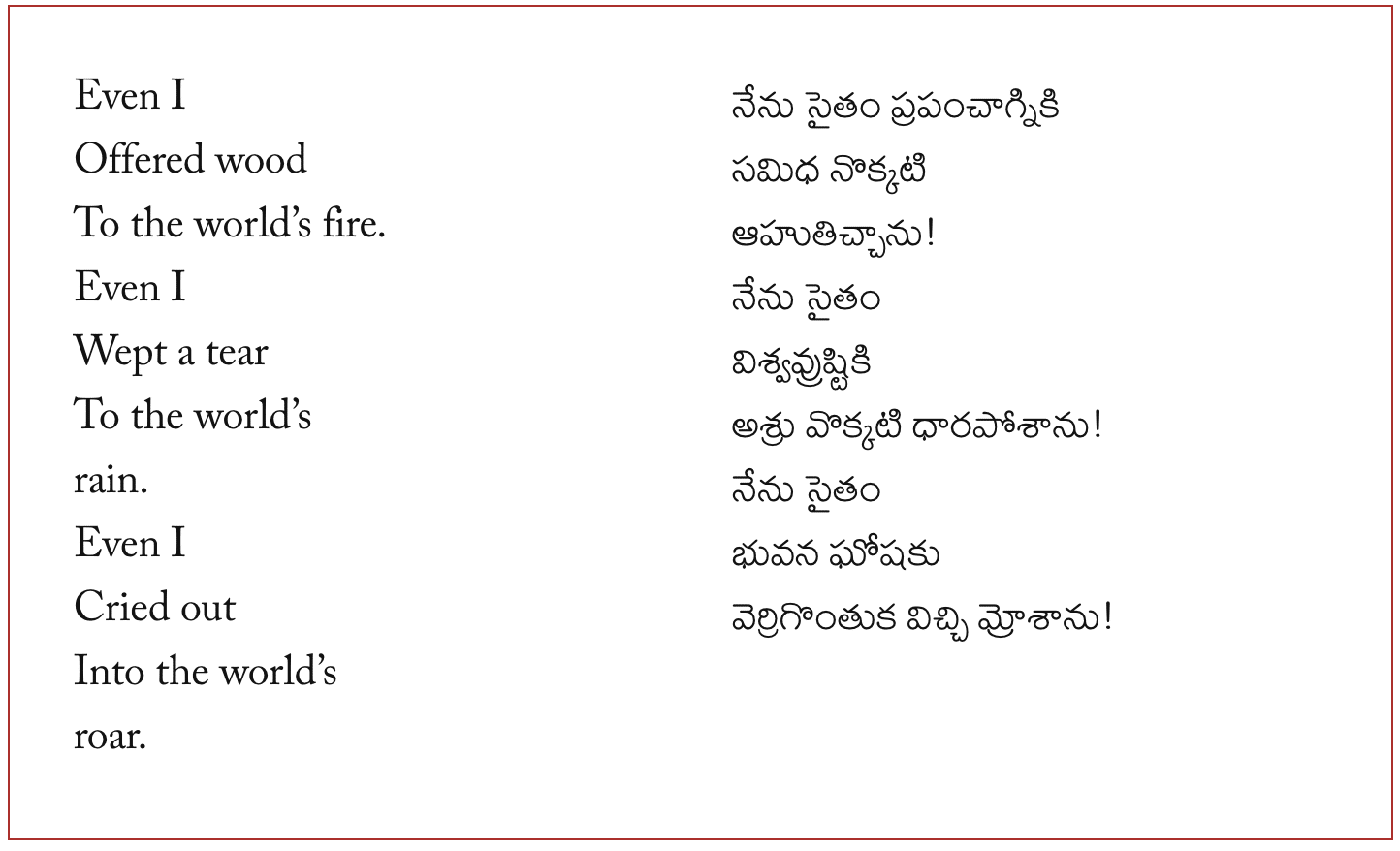
The fight against colonialism, monarchy, and landlordism had to take place through struggles in the fields and streets, but these struggles required people to develop their confidence and belief that they could not only take on the structures of power, but that they could win. That confidence and belief are produced through struggle, but also through imagination. That is why the AMS, like so many other anti-colonial mass movements, emphasised the role of song and theatre in reaching more and more people and shaping their understanding of the world. Through this work, the AMS became part of popular culture and the subject of songs that have remained embedded in the struggles in the region for decades, such as Padavekku Andhra Maha Sabha Padava (Climb the Andhra Mahasabha Boat), its author unknown:
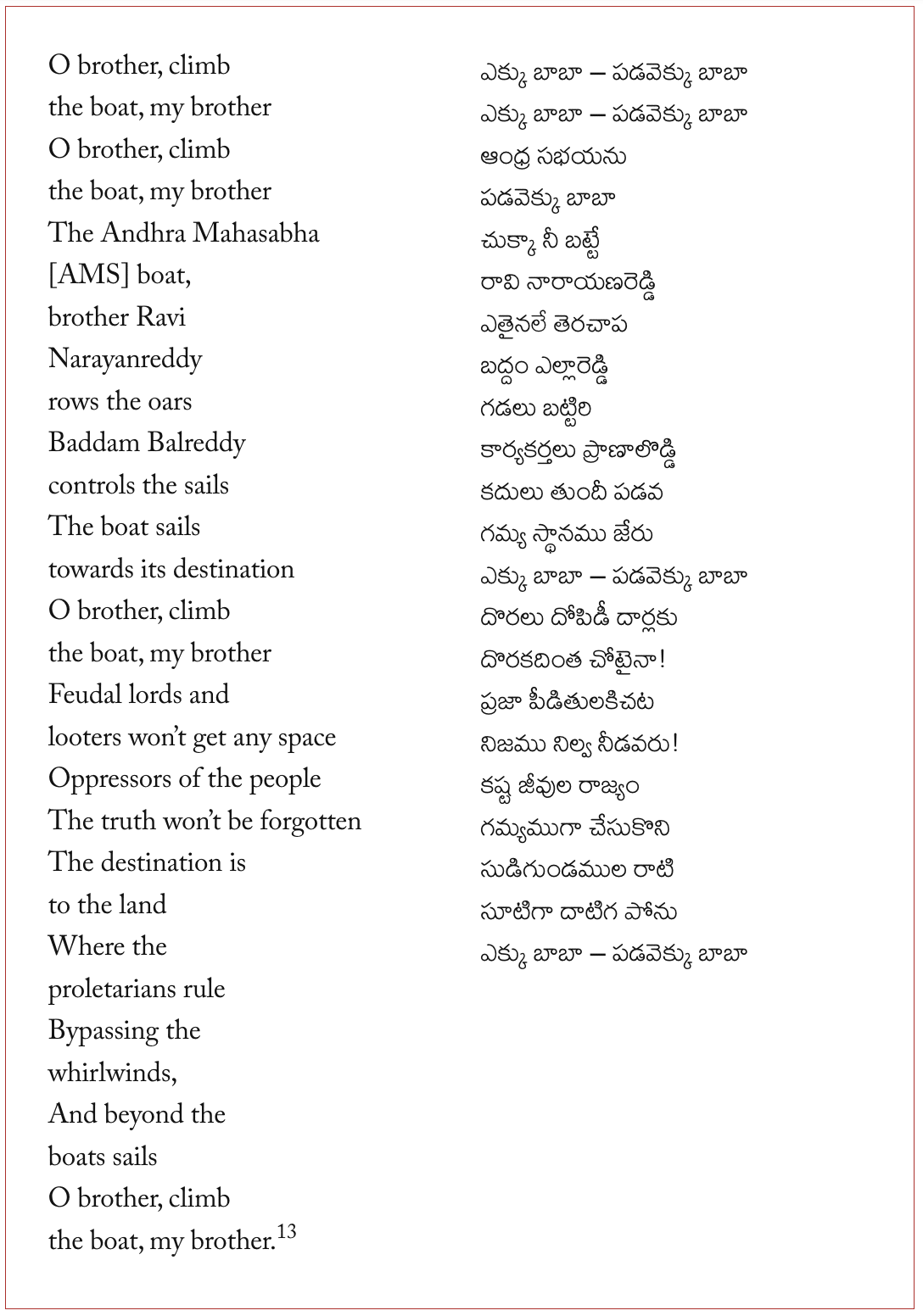
7. Listen to the song ‘Join the Communist Party, O Bonded Farmworker’, written by Suddala Hanumanthu and performed by Abbagani Biksham on 23 July 2024.
8. This portrait of Suddala Hanumanthu portrays the different roles he played, from left to centre, as a revolutionary fighter of the Telangana armed struggle holding a rifle and then, to the right, holding the instrument tanpura, which he often used in his songs. The illustration to the far right depicts a village boy who is the subject of Hanumanthu’s song Palleturi pillagada pasulagaase monagaada (Village Boy [bonded child worker] Who Can Herd the Animal Expertly) who was taken away from his mother by the landlord and turned into a bonded worker forced to herd cattle. Credit: Kurella Srinivas, 2016
9. An actress performs in a street play written by Praja Natya Mandali and pokes fun at haughty middle-class sensibilities, n.d. Credit: Praja Natya Mandali Photography Archives
10. Viplava Rachaitala Sangham (Virasam) and Jana Natya Mandali members Varavara Rao, K Balagopal, Gummadi Vithal Rao (left to right), and Vangapandu (far right) 1990. Credit: N. Venugopal’s personal collection
11. Cassette, VHS, and CD covers of Praja Natya Mandali plays and songs. Credit: Praja Natya Mandali, 2024
The Telangana Armed Struggle
The entry of young radicals into the AMS in the 1930s transformed not only the organisation, but also the political world in Telangana more broadly. These young communists forced the AMS to change its membership rules to allow the poor and illiterate to join in large numbers. In turn, these new members began to demand that the organisation go beyond its cultural work and adopt resolutions in 1941 calling for the abolition of vetti (caste-based forced labour) and the jagirdari (landlord) system and for the enforcement of tenants’ rights. Popularly called the Sangham (Association), the AMS spread across rural Telangana, breaking caste barriers in a revolutionary way.14 The AMS also attracted writers and artists who wanted to contribute their talents to the struggle to democratise society and end the colonial-Nizam structure.
This radicalisation took place not only within the AMS membership and its artistic practice, but across the Indian subcontinent amongst artists and writers. In 1936, left-oriented writers and artists formed the All India Progressive Writers’ Association (PWA), which was led by prominent figures such as Premchand (1880–1936), Rabindranath Tagore (1861–1941), Mulk Raj Anand (1905–2004), Khwaja Ahmad Abbas (1914–1987), and Sarojini Naidu (1879–1949). By 1943, theatre artists created the Indian People’s Theatre Association (IPTA).
The Andhra region was not immune to the immense impact of the PWA and the IPTA. The first PWA conference in Andhra was held in 1943, the same year that the IPTA was founded in Mumbai. The IPTA’s opening event was attended by the Urdu poet Makhdoom Mohiuddin (1908–1969) and Telugu theatre director Garikapati Rajarao (1915–1963), who, within months, held the first IPTA meeting in the Andhra region in Vijayawada on 1 June 1943. Three years later, in May 1946, the PWA organised its first literary summer school, out of which emerged the Praja Natya Mandali (People’s Theatre Group, or PNM).15
The growth of the PWA and IPTA in the Andhra region took place in the context of an intense struggle between the Nizam’s forces and the peasants of Telangana. The Nizam, asked by the British colonial state to contribute food grains as a war levy, began to confiscate the harvest of poor peasants. The communist poet Bandi Yadagiri wrote Nyzaam Sarkaroda (O Nizam, the Ruler) about this remarkable peasant struggle:

In an effort to contain the growth of the communist influence on peasants in Palakurthi village (Jangoan district), Visnur Ramachandra Reddy, the Nizam official who ruled over that territory (known as a deshmukh), usurped the land of AMS member Chityala Ailamma – an experience that was far too familiar to peasants at that time. Twenty-eight peasants, led by the local AMS leaders, gathered to defend Ailamma’s harvest and chased off two hundred of the deshmukh’s thugs. In response, the deshmukh sent his men to seize the AMS leaders, who were arrested and then tortured. After months of struggle, on 4 July 1946, a thousand peasants marched against the deshmukh. His thugs fired on the march, killing Doddi Komaraiah, a poor peasant, member of the Communist Party of India, and leader of the local AMS organisation. The procession gathered, marched to the home of the deshmukh, and set it on fire. Over the next week, the peasants – organised by the Communist Party of India (CPI) – seized two hundred acres of land from the deshmukh and distributed it to the landless peasants. The Telangana Armed Struggle had begun.17
Under the leadership of the CPI, the peasant unrest spread across the countryside. Neither the Hyderabad State Forces nor the Razakars (a paramilitary volunteer force in Hyderabad) could stem the tide. Village after village liberated itself from the Nizam’s rule, forming grama rajyams (village communes) that assaulted social hierarchies and redistributed land. Men and women from all caste backgrounds participated in the armed squads and fought to build a vast liberated zone that covered almost five thousand villages.18
The Praja Natya Mandali hastily wrote songs and plays to educate and inspire the rebellious peasantry, and activists from across the Andhra region travelled to Telangana to train and inspire people and bring more artists into the fold.19 The most iconic play produced in this period was Maa Bhoomi (Our Land), written in 1947 by the communist artists Sunkara Satyanarayana and Vasireddy Bhaskara Rao (both from the Krishna district in the Andhra region).20 The play was based on the police repression that took place in two hundred and forty villages in the district of Nalgonda, the epicentre of the Telangana armed struggle, where the Nizam’s state arrested 15,350 people, tortured them (including by raping 74 women), and killed 52 in custody. The play begins with the story of Bandagi, a Muslim peasant who was killed so that the deshmukh could seize his land, and then follows the story of the people rising up with the AMS as their instrument.21 The deshmukh tried to break the AMS by stoking religious and caste differences but did not succeed. The play closes at a graveyard, where the people have come to commemorate Bandagi and pledge to continue the fight under the AMS, seize and cultivate land, and excommunicate from the village all those who collaborated with the Nizam’s state. By the end of 1948, 125 groups had performed Maa Bhoomi and at least twenty million people had watched the play.22
These plays inspired and educated millions of people through their performances while transforming the culture of theatre and art across the region. As Kondapalli Koteshwaramma (1918–2018), a communist writer who participated in the Telangana struggle, recalled, ‘During that period, women were not allowed to act in plays. So, the women comrades used the example of Bengal, where Rabindranath Tagore’s daughter was acting in a play. The senior leaders agreed to our demand, and we were able to act in plays’. The first play where women acted alongside men was Sunkara and Vasi Reddy’s Mundadugu (A Step Forward).23
Moturu Udayam (1924–2002), a communist and leader of the Andhra Mahila Sabha (Andhra Women’s Association), was underground during the armed struggle but participated in the first IPTA meeting in Vijayawada. The first woman to ride a bicycle in the region, Udayam led the cultural group Burrakatha Squad, which organised activities such as plays, including one about the Soviet war-time hero Tanya.24 While in one of her stints in prison, in 1947, Udayam wrote Chevulapilli Magistrate (The Rabbit-Eared Magistrate) to protest the inhumane conditions in prisons. Later, she recalled that some inmates who watched the play became communists while in prison as a result.25
During the armed struggle, the poet Suddala Hanumanthu (1908–1982) wrote the song Palleturi pillagada pasulagaase monagaada (Village Boy [bonded child worker] Who Can Herd the Animal Expertly), which was used in the play Maa Bhoomi and then in the 1979 film version.26 Hanumanthu, who was from Nalgonda (the epicentre of the Telangana armed struggle), worked for the Nizam’s government for a short period before becoming a communist, moved by his anger at the way the Nizam’s state operated. He spoke of witnessing incidents such as a government officer beating up an old man for refusing to carry his luggage and the impact this had on him. Hanumanthu was inspired by the people’s resistance against the routine degradation and exploitation imposed upon them by the Nizam’s government. He wrote the song Vey vey debbaku debba (Give a Blow for Every Blow You Receive), taking the title from the words uttered by an elderly woman when an AMS meeting was attacked by the Razakars:
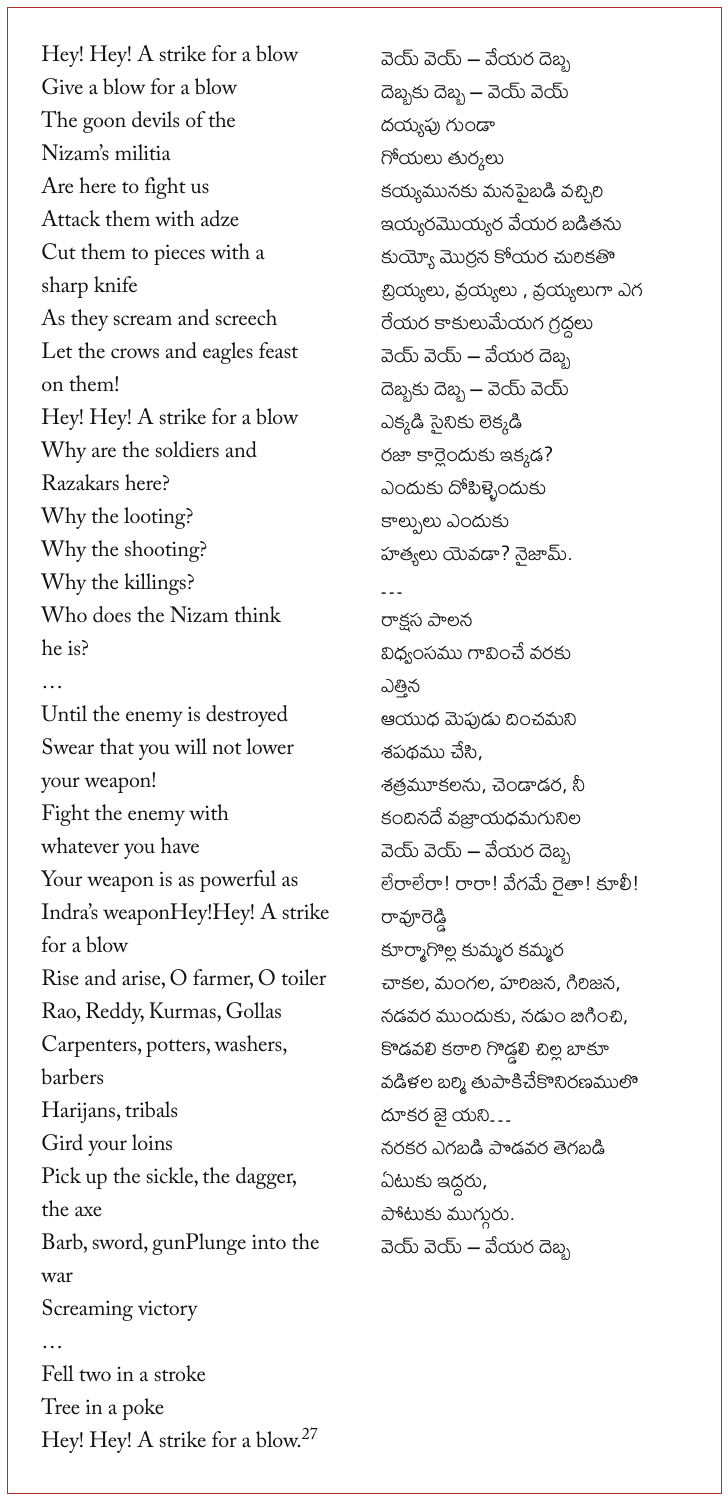
The peasantry made substantial gains in dethroning the landlords and building a socialistic productive base during the Telangana armed struggle, which lasted from 1946 to 1951. One million acres of land were distributed to farmers in this period, which were then facilitated and overseen by people’s committees. Vetti (caste-based forced labour) was abolished, as was the practice of keeping devadasis (sex slaves). The people transcended narrow identitarian affiliations and forged strong social bonds. Lines from popular songs of the armed struggle make this clear, such as ‘caste does not give you food, my brother; we must fight together’. None of this would have happened without the contribution of people’s artists, singers, and balladeers, whose songs and plays inspired millions of the poor and oppressed to imagine a world in which they would no longer be enchained while building their confidence to fight for it.28
In 1948, the Nizam was eager for Hyderabad to remain independent from the newly formed India, which irked Prime Minister Jawaharlal Nehru and the Indian government. For that reason, the Indian government sent the army to seize Hyderabad and incorporate it into the Indian union. After it had overthrown the Nizam’s state, the Indian army turned its guns against the AMS leaders and the radicalised peasantry. P. Sundarayya (1913–1985), a communist leader who was key in the Telangana armed struggle, reported:
As many as 4,000 communists and peasant militants were killed; more than 10,000 communist cadres and people’s fighters were thrown into detention camps and jails for a period of three to four years; no less than a minimum of 50,000 people were dragged into police and military camps from time to time to be beaten, tortured, and terrorised for weeks and months together; several lakhs [hundreds of thousands] of people in thousands of villages were subjected to police and military raids and suffered cruel lathi charges [baton beatings]; the people in the course of these military and police raids lost properties worth millions of rupees which were either looted or destroyed; [and] thousands of women were molested and had to undergo all sorts of humiliations and indignities.29
In 1950, Sri Sri published his poems in a collection called Maha Prasthanam (Great Journey), which turned the work of this communist poet into the soundtrack of a people. In 1951, the CPI officially called off the Telangana armed struggle, though fighting continued in some areas. In 1956, the new Indian government crushed what remained of the armed struggle and created the state of Andhra Pradesh. But even then, its legacy remained. Nehru was forced to accept some aspects of the land redistribution achieved during this period, and the people never forgot the songs.
12. A performer waves a red flag in the Praja Natya Mandali street play Veera Telangana (Heroic Telangana), symbolising the popular overthrow of the feudal system under the leadership of the communist movement. Credit: Praja Natya Mandali Photography Archives, c. 2000s, photographer unknown
13. Listen to a song (www.youtube.com/watch?v=3UzhJneaYV4&t=181s) by Suddala Hanumanthu about the importance of getting organised and fighting for a peasant-workers’ rule, like in the Soviet Union and China, performed by Abbagani Biksham on 23 July 2024.
14. Makhdoom Mohiuddin, a revolutionary Urdu poet who played a key role in establishing the Communist Party of India in Hyderabad when it was under the Nizam’s rule. Credit: Kurella Srinivas, 2016
The Red Star Keeps Shining
In the 1952 parliamentary (Lok Sabha) elections, the first under the 1950 Constitution, sixteen communists won seats. Seven of these seats represented the area in which the Telangana armed struggle took place. An eighth seat was won by Harindranath Chattopadhyay (1898–1990), an independent candidate backed by the CPI and the younger brother of Sarojini Naidu (former Congress president and poet) and Virendranath Chattopadhyay (a leader in the Communist International). At the time of the armed struggle, Chattopadhyay wrote the poem ‘Tales of Telangana’, which was widely distributed across the region and the country:
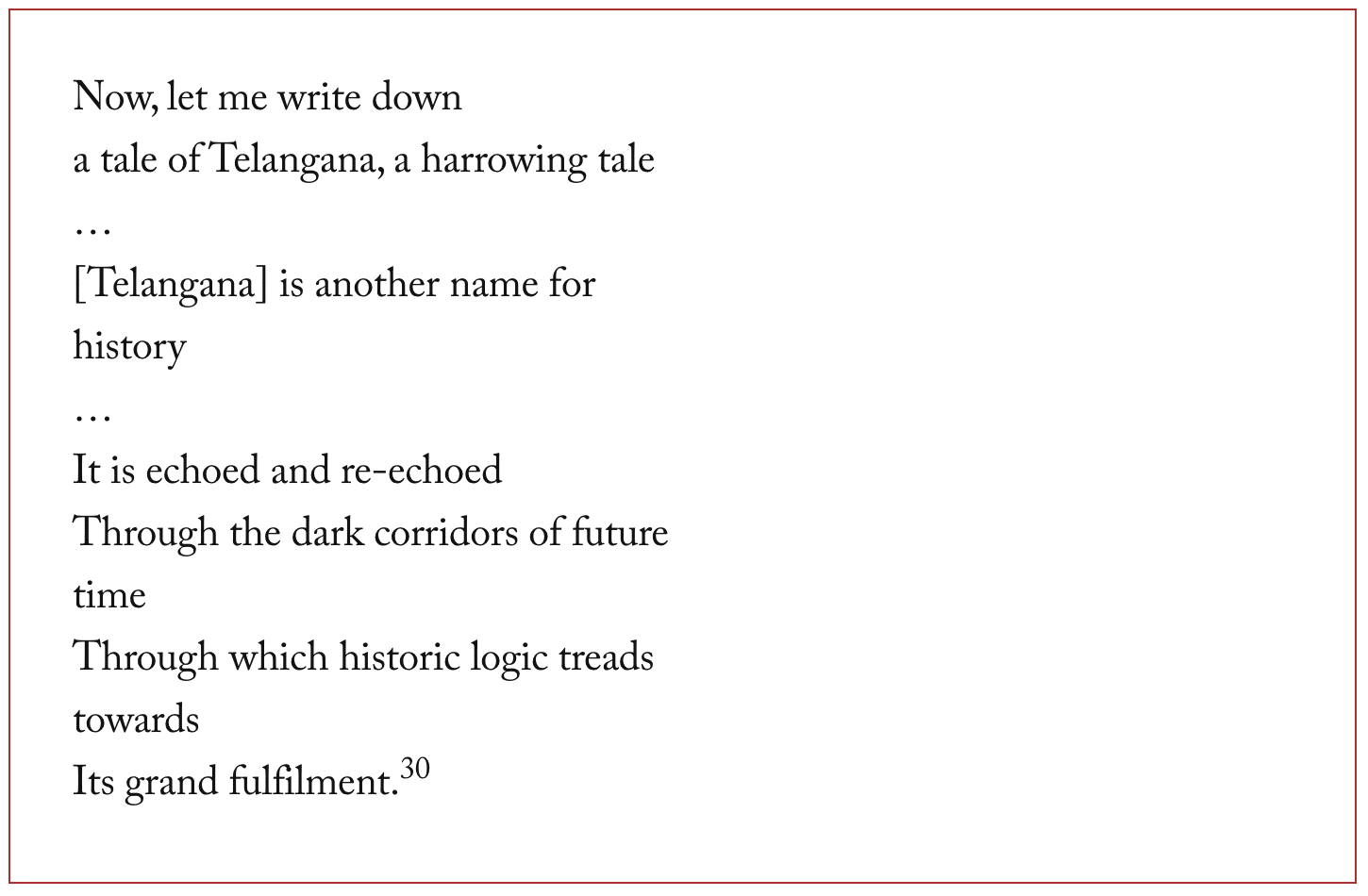
The echoes of the Telangana armed struggle have indeed reverberated across time.
The Telangana armed struggle was an episode in a longer history of peasant agitation for their own liberation that dates back before the armed struggle started in 1946 to peasant protests that led to the first Andhra Pradesh anti-zamindari (landlord) conference held in Nellore in September 1931 and to a historic march of kisans (farmers) from Ichchapuram (Srikakulam district) to Madras in 1937. It was this cycle of peasant protests that led to the formation of the regional branch of the All India Kisan Sabha (All India Farmers’ Union, or AIKS) and then to the region being selected twice to host the AIKS conference, once in Palasa (1940) and again in Vijayawada (1944). The AIKS mobilised 100,000 peasants for the Vijayawada meeting and, at its conclusion, led a mass campaign in 2,000 villages to take the message of the peasant struggles to the people. The following year, 50,000 peasants marched from their villages to Tenali (Guntur district) for the Andhra region’s Kisan Sabha Conference.31 The peasant struggles escalated into the Telangana armed struggle and remained intact through a new cycle of unrest that began in the 1960s.
When the state of Andhra Pradesh was created in 1956, the Indian government began to develop commercial agriculture in the region, exacerbating the already existing problems in the countryside, such as inequality along caste lines and the advantages secured by certain dominant castes over the state, both of which led to deepened deprivation and violence against the oppressed castes, particularly landless labourers. This provoked resistance amongst the peasantry in the region, which forced the government to empanel a land reform inquiry and pass reforms such as the 1955 Telangana Abolition of Inams Act.32 This struggle was a direct outcome of the peasant movement in the region.
The mild reforms passed in the immediate aftermath of India’s independence did not solve the crisis facing agricultural workers and peasants. The promise of the Telangana armed struggle remained alive and would rise again and again in myriad forms, including armed peasant uprisings and the poetry that emerged alongside these uprisings.
On 31 October 1967, more than a decade after the armed struggle came to an end, Koranna and Manganna, two communist peasants living in the village of Levidi, were on their way to the Girijan Samagam Conference (Girijan means ‘hill people’ and refers to a group of Adivasi, or tribal, peoples who live in the hills that stretch along the eastern edge of India known as the Eastern Ghats). Before they arrived at the conference, they were stopped by landlords from the village and subsequently killed. When news of their murder reached the conference, the Girijans retaliated by attacking the landlords, and the struggle spread across the region. For an entire year, the Girijans and other tribal peasants attacked landlords and police stations across this part of Andhra Pradesh. This was the start of a new phase in the peasants’ intensified struggle against the authorities. The rebellion spread to nearby districts, including Srikakulam, which became its epicentre. Three men emerged as the leaders of this uprising: Subba Rao Panigrahi (1933–1969), who had been a temple priest, Vempatapu Satyanarayana or ‘Satyam’ (1934–1970), who was a schoolteacher, and Adibhatla Kailasam (who was killed in 1970 alongside Satyam), who was also a schoolteacher. They mobilised large numbers of peasants, including Adivasis, to join their armed bands associated with the Maoist-oriented Communist Party of India (Marxist-Leninist). The Indian government, eager to snuff out this Maoist rebellion, sent 12,000 troops to the area. All three of these leaders were killed, and the movement eventually dissipated.
In the late 1960s, in the midst of this revolutionary ferment, the filmmaker B. Narsing Rao (born in 1946) set up the Art Lovers’ Association in rural Hyderabad, which held weekly meetings to discuss the need to create revolutionary art that would meet the needs of the peasant struggles. Out of these meetings, the members – many now within the Maoist movement – formed the Jana Natya Mandali (People’s Theatre Group, or JNM). Inspired by the communist tradition of popular art, the JNM collected, preserved, and shared thousands of folk and revolutionary songs and travelled to villages around Hyderabad to collect poems and share poetry they had written.
On 4 July 1970, radical artists and writers set up the Maoist-oriented Viplava Rachaitala Sangham (Revolutionary Writers’ Association, also known as Virasam) under the leadership of Sri Sri as its founding president. These writers and artists were inspired by the Marxist cultural theories of Joseph Stalin and Mao Zedong, who said, respectively, that art must be ‘proletarian in content, national in form’ and must move ‘from the masses to the masses’.33 Virasam started a monthly magazine called Arunatara (Red Star) in which it published poetry alongside political analyses. Among the most important contributions was the poem and song ‘Narudo Bhaskarudo’ (O human! O Bhaskar!, 1970) by K. G. Satyamurthy (1931–2012, also known by his underground name Sivasagar), since it was the first of its kind in Telugu to make poetry accessible to the people in colloquial language.34 The song, which paid tribute to a martyr named Bhaskar, goes:

Inspired by these radical traditions, the young folk singer Gummadi Vithal Rao (1949–2023) went to a Virasam meeting and spoke with Narsing Rao, who later made revolutionary films such as Maa Bhoomi (Our Land, 1979) and Daasi (Slave Woman, 1988). ‘A revolutionary song’, Narsing told Vithal, ‘should represent the struggles of the people to make a living, and their everyday struggles to overcome this condition’.36
In his search to create such revolutionary songs, Vithal and his group came across this popular folk song ‘Apura Bandodo’ (Stop, O Cartman):
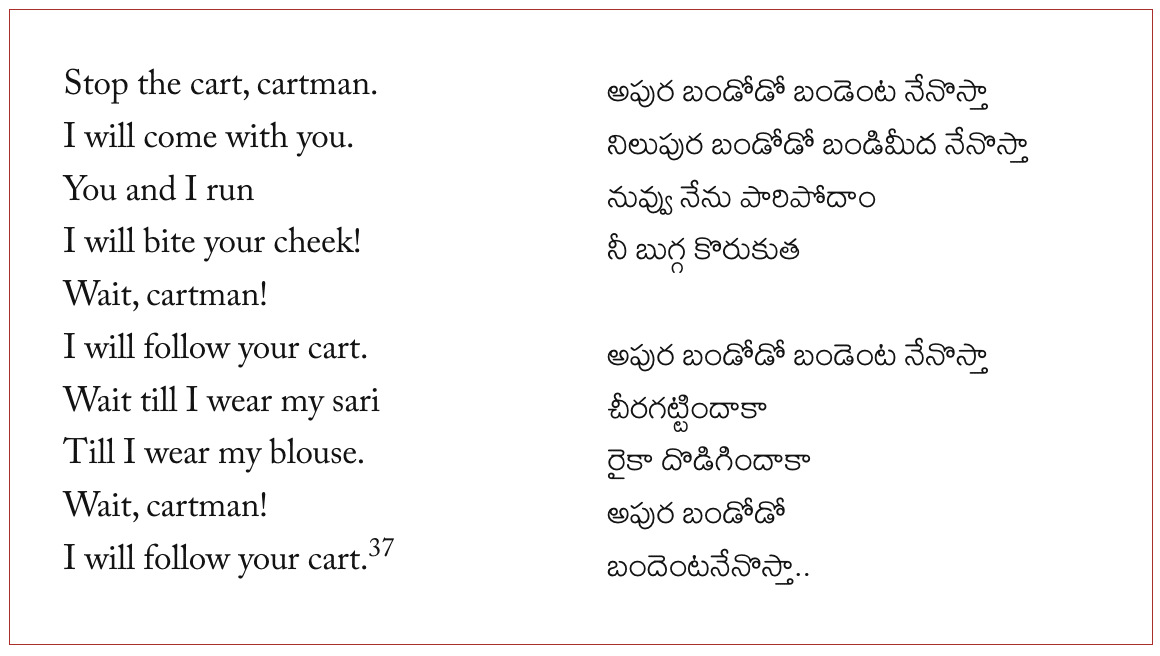
On reflection, this seemed too romantic, not exactly representative of the difficult life of a cartman. Using this song’s tune, Vithal wrote a version that resonated more with the people:
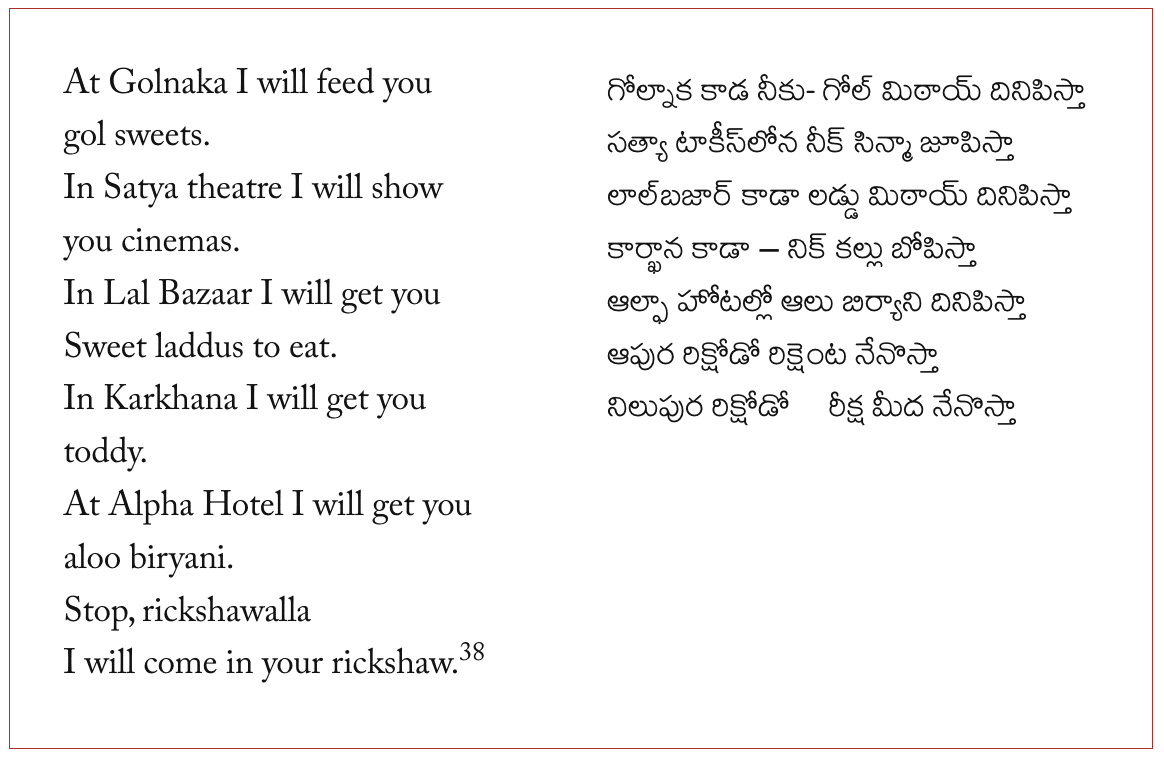
But even this seemed inadequate. Where was the narrator going to get the money to buy these treats for the rickshaw puller? So, Vithal continued in his search for the right tone:
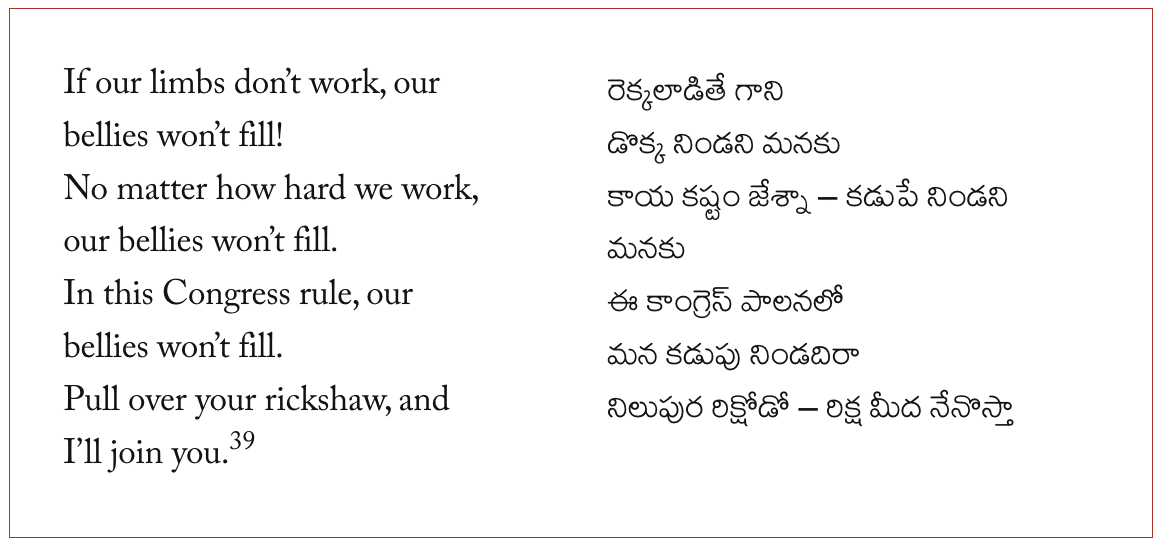
The song, in its latest and final iteration, became a sensation, and its author Gummadi Vithal Rao quickly acquired the nickname Gaddar (Revolt). By the time he died in 2023, at the age of 74, Gaddar had become Jana Natya Mandali’s most popular artist and had written and sung over 5,000 songs, many of which have passed into folklore, adored by millions who are often unaware of their origin.40
The son of landless peasants who belonged to an oppressed caste in Tupran village in the Medak district of Telangana, Gaddar dropped out of an engineering college for financial reasons. In 1972, he joined the People’s War Group. During the Emergency (1975–1977), when the Indian government set aside the Constitution, he was arrested and jailed for forty-five days. In 1986, he went underground and worked in the Dandakaranya forest for eight months. In 1992, he set up the Bodhi School for children from poor families and those whose parents were killed in police encounters. In 1995, he was suspended from the People’s War Group for writing songs for a mainstream movie. On 6 April 1997, unidentified gunmen attempted to assassinate him. He was shot six times. He survived but lived the rest of his life with a bullet lodged in his backbone. It did not stop his songs.41
15. A troop (dalam) of the Telangana armed struggle marches in the late 1940s. Credit: Sunil Janah
16. KG Satyamurthy, popularly known as Shivasagar, a founder of the People’s War Group who wrote the popular elegy and song in Telugu ‘Narodo Bhashakrudo’ (O Human! O Bhaskara). Credit: Kurella Srinivas, 2016
17. Members of a troop in the armed struggle pause to eat, late 1940s. Credit: Sunil Janah
18. Adivasi artists with traditional musical instruments during a public procession. Credit: Praja Natya Mandali Photography Archives, n.d.
Art Must Move from the Masses to the Masses
Songs are deeply embedded in the landscape and struggles of the Telugu-speaking people. It is in songs that histories are preserved; it is in songs that the class struggle manifests by contesting historical interpretations; and it is through songs that new struggles that enhance social cohesion and confidence germinate.
A range of cultural artifacts across the world contest the ferocious power of landlords, who not only demand power over the surplus produced by the peasantry, but also forms of devotion that are incompatible with humanity. In 1927, a young Mao Zedong (1893–1976) went to Hunan to investigate the conditions of the peasantry and asked:
Even if ten thousand schools of law and political science had been opened, could they have brought as much political education to the people, men and women, young and old, all the way into the remotest corners of the countryside, as the peasant associations have done in so short a time?42
It was these peasant associations that introduced the peasantry to new slogans to give them confidence. It was these peasant associations and their linked cultural units, with their plays and songs and slogans, that helped to break the thousand-year power of the landlord class.
The idea that god, or gods, bestowed economic and political power to the monarchy and landlord class is deeply rooted among the peasantry. To dismantle that idea requires immense courage, organisation, and confidence, which is exactly what the combination of political and cultural struggle provides. If land is redistributed but the peasant still sees the landlord as divine, the old dominant classes will always return to power. It is the political struggle that breaks the power of the ruling class, but it is the cultural struggle that sustains that victory and allows both the landlord and the peasant to eventually become human.
19. Listen to the song (www.youtube.com/watch?v=3UzhJneaYV4&t=304s) Palleturi pillagada pasulagaase monagaada (Village Boy [bonded child worker] Who Can Herd the Animal Expertly), written by Suddala Hanumanthu and performed by Abbagani Biksham on 23 July 2024.
20. Members of a troop of the armed struggle in camouflage, late 1940s. Credit: Sunil Janah
21. Communist Party members measure and mark land for distribution to the landless in liberated villages using rope made of plant fibre, late 1940s. Credit: Sunil Janah
22. A member of the Communist Party teaches anatomy to villagers in the late 1940s as part of a movement that brought literacy and science to the people in the liberated villages. Credit: Sunil Janah
23. Communist poet and revolutionary Bandi Yadagiri who wrote ‘O Nizam, the Ruler’. Credit: Kurella Srinivas, 2016
Notes
1. V. Ramakrishna, ‘Left Cultural Movement in Andhra Pradesh: 1930s to 1950s’, Social Scientist 40, no. 1–2 (January–February 2012), 21–30.
2. Mallu Swarajyam, Na maate Tupaki tutalu [My Words Are Like Bullets] (Hyderabad: Hyderabad Book Trust, 2019), 23, our translation.
3. Swarajyam, Na maate, 23, our translation.
4. K. Navaneetham and C. S. Krishnakumar, ‘Mortality Trends and Patterns in India: Historical and Contemporary Perspectives’, in Shaping India: Economic Change in Historical Perspective, eds. D. Narayana and Raman Mahadevan (New Delhi: Routledge, 2020), 266–294.
5. Andhra and Telangana are both part of the Telugu-speaking region. Before independence, Andhra was under British rule, while Telangana was under the rule of the Nizam of Hyderabad. After independence, and after concerted struggle, the two regions were shaped into the state of Andhra Pradesh (1956). In 2014, the state was divided into Andhra Pradesh and Telangana.
6. Tameshnie Deane, ‘The Devadasi System: An Exploitation of Women and Children in the Name of God and Culture’, Journal of International Women’s Studies 24, no. 1 (2022): 8.
7. A. K. Prabhakar, M A Telugu Janapada Vibhagam (Hyderabad: Dr B. R. Ambedkar Open University, 2009).
8. S. V. Satyanarayana, Telugulo Udyama Geethalu [Social Movement Songs in Telugu] (Hyderabad: A. P. Progressive Writers Association, 2005), 54–56, our translation.
9. Satyanarayana, Telugulo Udyama Geethalu.
10. P. Sundarayya, Telangana People’s Struggle and Its Lessons (Calcutta: Communist Party of India (Marxist), 1972), 3.
11. Adapa Satyanarayana and Dyavanapalli Satyanarayana, Telangana History, Culture, and Movements (From Pre-History to Formation of the State) (Hyderabad: Telangana Publications, 2022); Adapa Satyanarayana, ‘The Pioneer of People’s Literature in Telangana’, The Hans, 1 November 2016, https://www.thehansindia.com/hans/opinion/news-analysis/how-hurricanes-will-change-as-earth-warms-890664?infinitescroll=1.
12. Sunil Purushotham, From Raj to Republic: Sovereignty, Violence, and Democracy in India (Redwood City: Stanford University Press, 2021), 190. Also see Rama Sundari Mantena, ‘The Andhra Movement, Hyderabad State, and the Historical Origins of the Telangana demand: Public Life and Political Aspirations in India, 1900–1956’, India Review 13, no. 4 (2014): 337–357.
13. ‘Padava Pata’, in Telangana Porata Patalu, ed. Jayadheer Tirumala Rao (Hyderabad: Sahiti Circle, 1990), 37, our translation.
14. Purushotham, Raj to Republic, 191.
15. Ramarao Peddi, ‘Theatre of the Marginalised. Politics of Representation’ (Ph.D. Thesis, University of Hyderabad, 2003), 200.
16. Yadagiri, ‘Naizamu Sarakroda’, In Telangana Porata Patalu, 96, our translation.
17. Sundarayya, Telangana People’s Struggle and Its Lessons, 26. See also, G. Kamalakar, ‘Tribal and Peasant Armed Struggle in Telangana’, Interaction 36, no. 1 (2018): 51–60; Dhanaraju Vulli, ‘Making Peoples History in Telangana Movement: Remembering Voyya Raja Ram Dhanaraju’, International Research Journal of Social Sciences 3, no. 6 (June 2014): 37–43.
18. Sundarayya, Telangana People’s Struggle and Its Lessons; Mohan Ram, ‘The Telangana Peasant Armed Struggle, 1946–1951’, Economic and Political Weekly 8, no. 23 (June 1973); Mohan Ram, ‘The Communist Movement in Andhra Pradesh’, Radical Politics in South Asia, eds. Paul Brass and Marcus Franda (Cambridge: MIT Press, 1973); Ravi Narayana Reddy, Heroic Telangana: Reminiscences & Experiences, no.17, October 1973 (New Delhi: Communist Party Publications).
19. V. Ramakrishna, ‘Left Cultural Movement in Andhra Pradesh’.
20. Srinath Sriperumbudur, ‘The Freedom Struggle and the Telugu Song, Theatre, and Cinema in South India’, Journal of Indian History and Culture, no. 28 (December 2021): 448–465.
21. For more on the struggle of Sheik Bandagi, see Devulapalli Venkateswara Rao, Telangana Peoples’ Armed Struggle (Devulapalli Venkateshwara Rao Research Centre, 2002), 31–39.
22. Ramarao Peddi, ‘Theatre of the Marginalised’, 252–288.
23. Stree Shakti Sanghatana, We Were Making History: Life Stories of Women in the Telangana People’s Struggle (London: Zed Books, 1989), 123.
24. Tanya was the nom de guerre of Zoya Kosmodemianskaia, a young Soviet communist who fought the Nazis but was captured early into the war and hanged. Her legend swept across the USSR and amongst communists the world over. Her life was made into an epic film, Zoya, by Lev Arnshtam in 1944. Ramarao Peddi, ‘Theatre of the Marginalised’, 201.
25. Sanghatana, We Were Making History, 194–195.
26. Vulli Dhanaraju, ‘Voice of the Subaltern Poet: Contribution of Suddala Hanumanthu in Telangana Peoples’ Movement’, Research Journal of Language, Literature, and Humanities 2, no. 7 (2015); K. Anandachary, ed., Prajakavi Suddala Hanumanthu Samagra Sahityam-Jivitam [Peoples’ Poet Suddala Hanumanthu Complete Works and Biography] (Hyderabad: Nava Telangana Publishing House, 2024).
27. Tirumala Rao, ed., Telangana Porata Patalu, 146, our translation.
28. Pasnoori Ravinder, Telangana Udyama Paata-Pradeshika Vimarsha [Telangana Movement Song[s]: A Regional Critique] (Hyderabad: Tena, 2016); S. V. Satyanarayana, Telugulo Udyama Geethalu [Social Movement Songs in Telugu] (Hyderabad: Potti Sriramulu Telugu University, 2019).
29. Sundarayya, Telangana People’s Struggle and Its Lessons, vii.
30. Reproduced in Sundarayya, Telangana People’s Struggle and Its Lessons, 383–414.
31. Telakapalli Ravi, ‘Peasant Struggles in Andhra Pradesh and Telangana: Reports from the Field’, Review of Agrarian Studies 5, no. 2 (2015): 114; Telakapalli Ravi, G. Raghupal, Sayyad Nissar, and Mahendra M. Reddy, Veera Telangana Maadi [Ours Is the Brave Telangana] (Hyderabad: Communist Party of India (Marxist), 2006); G. Raghupal and B. Venkateswarlu, Sy Sy O Nallagonda Veerudu [Be Ready, Nalgonda Hero] (Hyderabad: Prajashakti, 2011); U. Ramakrishna, Krishna Jilla Communist Udhyama Gathalu: Tyagadanula Veercharitralu [Stories of the Communist Movement and Valiant Sacrifice in Krishna District] (Vijaywada: Communist Party of India (Marxist), 2012); K. Anandachary, P. V. Krishna Rao, and Nunna Nageswara Rao, Khammam Zilla Communist Yodhulu [The Communist Fighters of Khammam District] (Khammam: Bodepudi Vignana Kendram, 2012); M. V. S. Koteswara Rao, C. H. Hari Babu, Sudha Kiran, Guntur District Communist Veerulu [Communist Martyrs of Guntur District] (Hyderabad: Prajashakti Book House, 2013); G. Raghupal and S. Yadgiri, Warangal Veera Gathalu [Legends of Warangal] (Warangal: Communist Party of India (Marxist), 2006); Y. Siddayya, Prakasam Zilla Amara Veerulu [The Immortal and Brave Fighters of Prakasam District] (Hyderabad: Prajashakti Book House, 2012).
32. K. Srinivasulu, ‘Caste, Class, and Social Articulation in Andhra Pradesh: Mapping Differential Regional Trajectories’, Working Paper no. 179, Overseas Development Institute, Osmania University, 2002, 8.
33. Joseph Stalin, J. V. Stalin Works, vol. 7 (Moscow: Foreign Languages Publishing House, 1954); N. Venugopal, Understanding Maoists: Notes of a Participant Observer from Andhra Pradesh (Kolkata: Setu Prakashani, 2013), 99; Tricontinental: Institute for Social Research, Go to Yan’an: Culture and National Liberation, dossier no. 52, 16 May 2022, https://thetricontinental.org/dossier-yanan-forum/.
34. Venugopal, Understanding Maoists.
35. K. G. Satyamurthy, ‘Narudo Bhaskarudo’, in Shivasagar Poetry, ed. Gurram Sitharamulu (Hyderabad: Anvikshi Publishers, 2019), 36–38.
36. B. Narsing Rao, Agni Sarassuna Virisina Vajraṁ [A Diamond That Bloomed in the Lake of Fire] (Hyderabad: Viswanatha Sahitya Peetam, 2023), 5, our translation.
37. Gaddar, My Life Is a Song: Gaddar’s Anthems for the Revolution, trans.Vasanth Kannabiran (New Delhi: Speaking Tiger Books, 2021), E-book.
38. Gaddar, My Life Is a Song, 44–64.
39. Gaddar, My Life Is a Song.
40. For more on Gaddar and for a selection of his songs in English translation, see My Life Is a Song.
41. Gaddar, My Life Is a Song; Keshav Kumar, ‘Singing for Revolution: Revisiting the Life and Lyrics of Gaddar’, Maidaanam, 3 October 2023, https://maidaanam.com/singing-for-revolution-revisiting-the-life-and-lyrics-of-gaddar/.
42. Mao Zedong, ‘Report on an Investigation of the Peasant Movement in Hunan’, in Selected Works of Mao Tse-tung, vol. 1 (Peking: Foreign Languages Press, 1965), 47.

